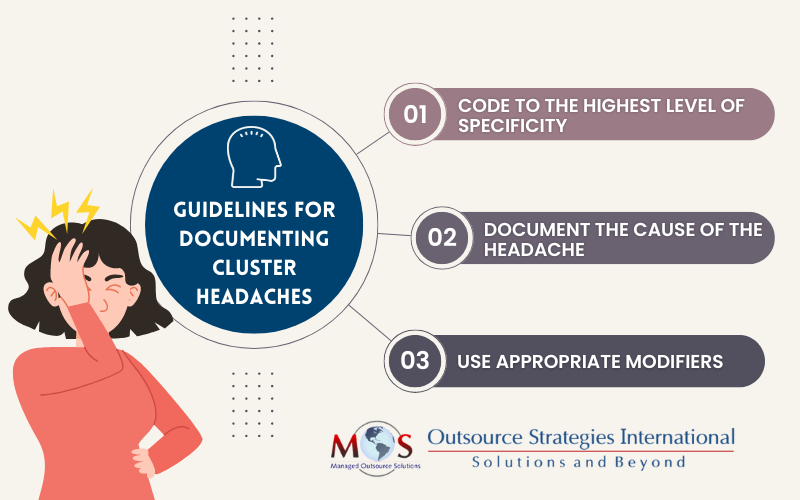Cluster headaches, categorized under primary headache disorders, present in cyclical patterns characterized by intense attacks followed by periods of remission lasting months or even years. Understanding cluster headaches, their types, and symptoms is necessary in order to assign the most accurate ICD-10 code. Whether reporting cluster headaches or other neurological conditions, partnering with an experienced medical billing company ensures accurate submission of claims with precise diagnosis codes. This can not only streamline reimbursement processes but also enhance patient care.
Cluster Headaches: Characteristics and Types
Neurologists diagnose cluster headaches through detailed physical examinations, and may conduct imaging tests to arrive at a definitive conclusion. This severe, recurrent headache disorder has certain unique characteristics:
- They involve intense, unilateral (one-sided) pain, often felt around the eye or temple region. Patients usually describe the pain as “burning” or “like a hot poker in the eye,” notes an American Academy of Professional Coders (AAPC) article.
- Attacks occur in groups or “clusters,” with headaches recurring between 1-8 times per day during a cluster period.
- The attacks come on suddenly and are extremely severe, but also tend to be relatively short-lived, usually lasting 15 minutes to 3 hours.
- Cluster cycles can last for weeks or months, followed by remission periods that typically last months or years without headache attacks.
In addition to the severe, one-sided head pain, other symptoms associated with cluster headaches can include:
- Tearing of the eye
- Redness of the affected eye
- Nasal congestion
- Eyelid drooping on the affected side
There are two types of cluster headaches: episodic and chronic.
Episodic cluster headaches occur on and off for one week to a year and are followed by a pain-free remission period that lasts three months or longer before another cluster headache develops.
Chronic cluster headaches might continue for more than a year and are followed by a pain-free remission period that may last less than one month. However, remission doesn’t occur in all cases.
Optimize your neurology medical billing and prevent denials!
Coding Cluster Headaches
The ICD-10 codes for reporting cluster headaches are:
G44.0 Cluster headaches and other trigeminal autonomic cephalgias
G44.00– (Cluster headache syndrome, unspecified)
G44.001 Cluster headache syndrome, unspecified, intractable
G44.009 Cluster headache syndrome, unspecified, not intractable
G44.01– (Episodic cluster headache)
G44.011 Episodic cluster headache, intractable
G44.019 Episodic cluster headache, not intractable
G44.02– (Chronic cluster headache)
G44.021 Chronic cluster headache, intractable
G44.029 Chronic cluster headache, not intractable
Points to note:
- Code assignment depends on whether the headache is episodic or chronic.
- A 6th character is necessary to indicate whether the headache is intractable (“1”) or not intractable (“9”).
- If sufficient clinical information isn’t known or available to classify the cluster headache as episodic, chronic, or intractable/not intractable, it is acceptable to report the appropriate unspecified code.
Accurately reporting all of the patient’s symptoms will be crucial if ordering a computed tomography (CT) scan. Providing a comprehensive symptom history can help demonstrate the medical necessity for the CT scan, which is used to rule out more serious underlying conditions that could be causing the patient’s headaches.
Patients with cluster headache commonly experience a combination of the following symptoms:
- Extreme sharp or stabbing pain, usually in, behind or around one eye. The pain can spread to other areas of the face, head and neck.
- Restlessness
- Tearing of the eye on the affected side
- Redness of the affected eye
- Nasal congestion
- Drooping of the eyelid on the affected side
- Stuffy or runny nose on the side that hurts
- Forehead or facial sweating
- Skin color changes on the side of the face that hurts
- Swelling around the eye on the side that hurts
Guidelines for Accurate ICD-10 Coding for Headache
When documenting cluster headache or any other type of headache, follow these guidelines provided by the AAPC:
- Code to the highest level of specificity: It is essential to be as specific as possible when documenting and coding headaches. This means using the most specific ICD-10-CM code available for the specific type of headache being treated. Additionally, it’s crucial to ensure that the documentation supports the use of a code for a specific type of headache, rather than just using a more general headache code.
- Document the cause of the headache: Clearly documenting the cause or etiology of the headache, such as trauma, infection, or an underlying medical condition, can help determine the most appropriate ICD-10 code to report. If the headache is due to an established underlying condition, such as hypertension or a brain tumor, both the headache and the underlying condition should be coded.
- Use appropriate modifiers: Modifiers can be appended to the CPT code to provide additional information about the headache, such as the type (e.g. chronic vs acute) and/or severity, as well as any procedures or treatments performed.
Complex documentation requirements and stringent regulatory standards governing neurological disorders can make neurology billing and coding quite challenging. Partnering with an experienced provider of neurology medical billing services can ensure that disorders like cluster headaches are reported accurately and efficiently. Professional medical coders will revert to the physician to clarify any questions or concerns about the documentation and to ensure that the coding accurately reflects the services provided.
Ensure proper reimbursement for neurology services with accurate medical billing and coding!





